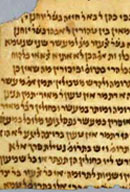The Other Talmud

A Jewish classic known as much for its obscurity as for its great significance took another step into the light this spring with the online publication of its oldest and most reliable version. The classic is the Jerusalem Talmud, and the version is a parchment manuscript, known as the Leiden manuscript, written in 1289 by a Jewish scholar and copyist in Rome.
Historically a step-sister to the larger and vastly more influential Babylonian Talmud, the Yerushalmi (to use its Hebrew name), composed in the 3rd and 4th centuries C.E., still fires imaginations. Despite its traditional designation, it was written not in Jerusalem but in the Galilee, and is thus often referred to in ancient sources as the Talmud of the Land of Israel and in scholarly literature as the Palestinian Talmud.
In the 5th century, anti-Semitism, economic travail, and the abolition by the Byzantines of the Jewish patriarchate put an end to the scholarly activity recorded in the Yerushalmi, and the center of rabbinic authority shifted eastward to the great academies of Babylon. There, generations of editors and redactors would rework myriad oral traditions and records of lectures and disputations into the polished if voluminous and complicated text of the Babylonian Talmud (the "Bavli"). By contrast, the Yerushalmi presents its texts and traditions tersely, betraying much less editing and conceptual rigging than the Bavli. This more stenographic presentation can make for more difficult but also thrilling reading.
The Yerushalmi never went entirely into eclipse. It was studied and used in Italian centers of learning that in turn influenced the foundations of Ashkenazic Jewry. It also continued to leave its traces in halakhic literature, particularly on matters where the Bavli was ambiguous or silent. Its abundance of non-legal, midrashic material also found a place in texts and collections.
First printed in the 1520s by Daniel Bomberg, the Yerushalmi sparked renewed interest in the 18th century when the Gaon of Vilna called for enriching the Bavli-centric rabbinic curriculum with its teachings. Although little studied in 19th-century yeshivas, it was seized upon by modern scholars seeking a richer historical understanding and by writers and polemicists for whom its very existence suggested a more dynamic conception of rabbinic origins. Religious Zionists, for their part, valued the Yerushalmi not only for its discussions of the significance of the Land of Israel but also out of the hope that this connection to the land, along with the Yerushalmi's raw and unfinished character, might offer a more primal and invigorated source of religious law.
Modern academic scholarship on the Yerushalmi is heavily indebted to Saul Lieberman, perhaps the greatest talmudist of the 20th century and the work's undoubted master. His student Yaacov Zusman supervised the publication of the Leiden manuscript in 2001, and Zusman's student Leib Moscovitz has published a guide to the Yerushalmi's obscure terminology. Still another Lieberman student, David Rosenthal, discovered last year a hitherto unknown passage from the Yerushalmi at the University of Geneva.
Other scholars, notably Peter Schäfer of Princeton, have studied the Yerushalmi in its wider historical and cultural contexts. In the meantime, the work is also making popular inroads with the appearance of a new translation into modern Hebrew, the first volumes of an English translation by ArtScroll, and a proliferation of websites and educational materials.
In all, the revival of interest in the Yerushalmi is yet another manifestation of the great contemporary resurgence in Jewish learning. Fragmentary, obscure, overshadowed (likely forever) by the Bavli, the Yerushalmi opens a precious window onto the ancient workshops that created the extraordinary world of rabbinic Judaism.
How do you know that SL was not in their class? The issue of chochmas yisrael and where he taught prejudices people, so you can't say that he is fairly evaluated or that his lack of influence reflects his actual stature as a Talmudist.
Would you say the same thing if the author wrote "perhaps the greatest talmudist of the 20th century" about the Chazon Ish?
(I mean, I hear where you are coming from, especially since somehow its always Louis Ginzberg or Saul Lieberman who get called that, but still.)
Luntz was born in Kovno in 1854, came to Jerusalem at 14 and studied at the Etz Chaim Yeshivah. He was a scholar of the Land of israel, and wrote a guide book of the land from Jerusalem to Syria.
His edition of the Yerushalmi is based on the first printed edition but compared to the Leiden, Vatican and Sirilio MSS and the writings of Rishonim in addition to his own learned commentary. It prefigured the Steinsaltzian type commentary by three quarters of a century.
Comments are closed for this article.




